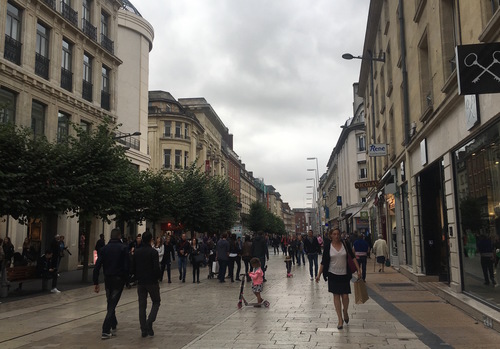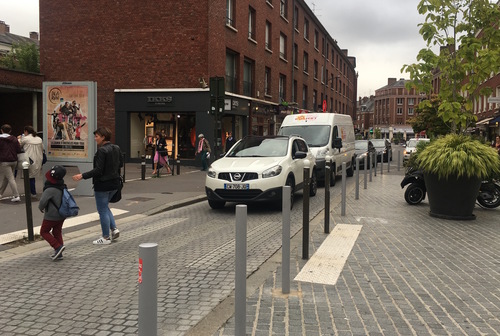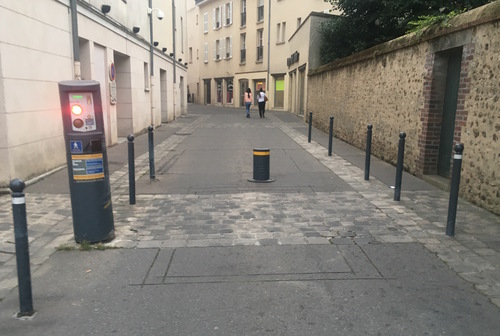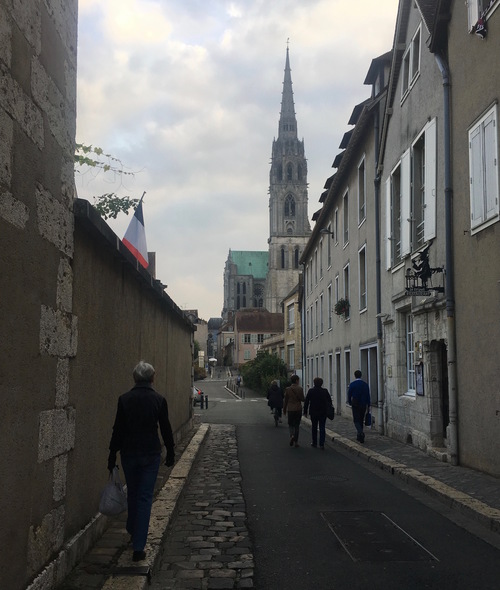Three examples of great street design in France
On a recent trip to France, I had my eyes open for smart design. Three cities in particular were full of examples of how to make streets for people rather than cars. Here’s what I noticed.
First, a small bit of context: the cities I visited were Amiens, Rouen, and Chartres, three regional capitals in northern France. Amiens and Rouen each have a little over 100,000 people, while Chartres has about 40,000. Here’s where they are in relation to the rest of the country:
1. Amiens
Amiens is a small city known for its soaring Gothic cathedral, which is the tallest completed cathedral in France. The cathedral was built to house a relic— a piece of John the Baptist’s skull— and was built at such a grand scale to accommodate pilgrims who would come to see it. In Amiens, a large pedestrian street (Rue de Cailloux) cuts through the heart of the city, taking you through rows of trees and water features and past stores, bakeries, banks, and more.
At points, Rue de Cailloux intersects streets carrying car traffic, but the roads narrow so much at these intersections that instead of pedestrians waiting for a break in cars to cross, the cars had to wait for a break in the people walking to drive through.
When my mom and I arrived, we got stuck in a long line of traffic; I was pleasantly surprised when I realized it was because of the significant volume of pedestrians milling across an intersection like the one pictured below.
2. Rouen
Rouen is another city known for its beautiful Gothic cathedral, which was painted by Claude Monet. A brief stop in Rouen to see the cathedral also meant stumbling onto a similar street. The Rue de General Leclerc in Rouen runs through the center of town and consists of two designated bus lanes flanked by a lane for pedestrians and cyclists.
Compared to Amiens, this pedestrian- and transit-oriented street wasn’t as bustling or green. Tourists seemed confused about where to walk and the few passing bicyclists would swerve into the bus lanes, which are separated by a low gutter rather than a steep curb. But the bus passengers waiting at stops up and down the street showed that the design provides a useful alternative for bus transit compared with the traffic-heavy streets surrounding Rue de General Leclerc.
3. Chartres
Chartres, a suburb about an hour and a half outside of Paris, is a delightful medieval town crowned with yet another awe-inspiring Gothic cathedral at its heart. The cathedral soars above the small medieval town below it, whose buildings are generally only three or fours stories and whose streets are often only just wide enough to accommodate a car.
Ultimately, the grand structure serves to put the human scale of the medieval town center into perspective. And the automated bollard system set up throughout this center limits the presence of cars, meaning you can stroll the streets and ponder that difference of scale in peace.
When cars do appear on the winding, narrow roads of Chartres centre ville, they share the space with pedestrians and cyclists.
Is our region full of towns woven through with small medieval streets? No. But that doesn’t mean cities like it can’t learn from the scale and prioritization put forth by cities like Amiens, Rouen, and Chartres (plus, Annapolis is pretty close).
Given that the Arlington County Board recently approved pedestrian-only streets, and that such streets in other cities have been reversed due to low pedestrian traffic, these French examples give us good fodder to consider what makes or breaks a street that is not primarily used by cars.
The primary key to a successful pedestrian street, it would seem, is a city that designs streets so that pedestrians feel safe and welcome. As Arlington moves forward with their plan, it will be interesting to see how they implement parallel plans to encourage walking and biking, and therefore the success of their newly approved car-free zones.







